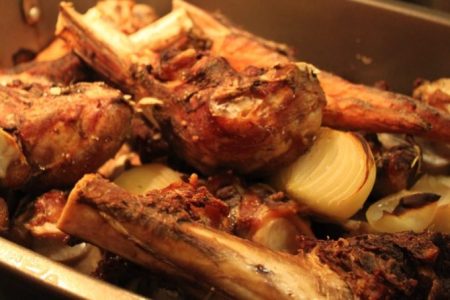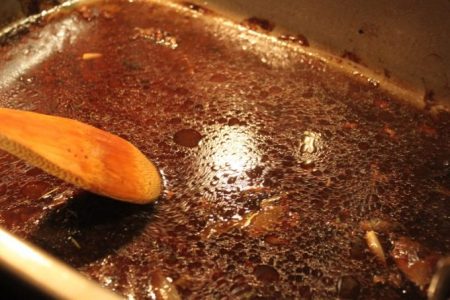With the shorter days and snow on the ground, hearty soups and stews are often on the menu. A good stock is the foundation of these recipes as well as the base for many sauces and gravies. If you hunt game meat, or know someone who does, don’t let those wonderful bones go to waste. Making your own stock from moose, caribou, or beef is surprisingly simple. A wild game stock can be used in any recipe that calls for chicken or beef stock or even water.
You will need a large stock pot. Making your own stock is best done in large batches. It is easy, but a time-consuming process, and I find it easier to make as much as I can at a time. The largest pot I had available was actually the pot to my pressure canner, so that is what I used. You will need bones with scrap meat attached, you can saw them into manageable sized pieces that will fit into your pot. The stock can be made right away, but I’m never prepared to do this in the middle of hunting season, so I freeze them until I have the time. You will also need some basic vegetables such as, onions, leeks, celery, fennel, and carrots among others can be used, as well as salt, pepper, garlic, other herbs and spices. And finally, you will need a storage system.
Stock can be stored in the refrigerator for 3-4 days. It can be frozen for up to a year, or made shelf-stable for up to a year when properly processed with a pressure canner. You cannot water bath can low acid foods.
Caribou, Moose, or Beef Stock
- 5-10# caribou, moose or beef bones
- 1 bunch celery
- 2 onions peeled and quartered
- 1/2 head peeled garlic
- 8-10 sprigs of fresh or 2 tablespoons dried parsley
- 8-10 sprigs of fresh or 2 tablespoon dried thyme
- 5 sprigs of fresh or 1 tablespoon dried rosemary
- 3 bay leaves
- 1 tablespoon black peppercorns
- 1 ½ – 2 cups of wine or water for deglazing
- Salt to taste
- Oil
- Enough water to cover
Place the bones and vegetables in a roasting pan, rub with oil and season with salt. I added 2 onions, a small bunch of celery, and a half head of peeled garlic. Carrots and other vegetables can be added, I don’t care for the sweetness carrots add so I didn’t use them. It’s your stock, add what you like. Roast at 400 degrees for about 40-60 minutes until they are deep brown, roast longer if needed to achieve the deep color. My house smelled amazing!
Save the browned bits from the bottom of the pan.
While the roasting pan is still hot, add about 12-16 ounces of wine or water to the pan to deglaze. Scrape all of the yummy bits off of the bottom and add it to the stock pot with the bones, and vegetables.
Fill the stock pot with water until the bones are just covered. Add herbs at this time. I added dried parsley, thyme and rosemary, a few bay leaves and a tablespoon of black peppercorns. A bouquet garni with fresh herbs would also be wonderful. Bring to a simmer, just so bubbles gently break the surface, don’t boil the bones, which can make the stock cloudy. I accidentally ended up bringing mine to a boil for a while before I noticed and it is cloudy, but it is still delicious.
Simmer for at least 4 hours. If you have the time, it can simmer for up to 12 hours which makes the flavors more intense. It needs to be kept at least 145 degrees to avoid spoilage. Skim foam periodically as needed. Add a little more water and lower the heat if you are getting too much evaporation.
When the stock is done, remove the bones, vegetables and herbs.
Strain through a very fine mesh strainer or a colander lined with three or four layers of cheesecloth.
Chill quickly, then refrigerate. Skim off the fat from that has solidified on top. I actually skipped this because I didn’t mind a bit of fat, caribou is pretty lean, and I didn’t have any space large enough to quickly chill the stock.
Bring the stock back to a boil, add salt to taste at this time if desired. Fill hot jars leaving 1-inch headspace. Wipe rims of jars with a dampened clean paper towel and place lids. Process in a pressure canner following the directions for your method. Check lids for seal after 24 hours, do not store any that are not vacuum sealed. Or freeze your stock making sure you leave enough space for expansion. Here is a guide for how to safely pressure can your stock. Here is some information on how to use your pressure canner.
Use your delicious stock as you would a commercial stock for any recipe that calls for chicken or beef stock.





